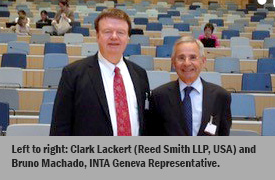INTA News
Country Names as Trademarks: WIPO Roundtable Discusses Current Best Practices
Published: May 15, 2018
Clark Lackert Reed Smith, LLP New York, New York, USA Geographical Indications Committee
 As the extent of country name protection continues to be debated, from “nation branding,” to new gTLD domain names, to possible sui generis protection, the World Intellectual Property Organization (WIPO) sponsored an informational roundtable of experts for the Standing Committee on the Law of Trademarks, Industrial Designs, and Geographical Indications (SCT) on April 24 in Geneva, Switzerland, on the subject.
As the extent of country name protection continues to be debated, from “nation branding,” to new gTLD domain names, to possible sui generis protection, the World Intellectual Property Organization (WIPO) sponsored an informational roundtable of experts for the Standing Committee on the Law of Trademarks, Industrial Designs, and Geographical Indications (SCT) on April 24 in Geneva, Switzerland, on the subject.
The roundtable was moderated by David Musker (School of Law at Queen Mary University of London, UK) and included representatives from intellectual property (IP) offices in Chile, the European Union, Georgia, Singapore, Switzerland, and the United States, as well as from the African Intellectual Property Organization. INTA was represented by Clark Lackert (Reed Smith LLP, USA) and Bruno Machado, INTA Geneva Representative. The International Federation of Intellectual Property Attorneys (FICPI) also was represented.
The roundtable lasted more than three hours and featured a wide-ranging discussion on the core topics of trademark protection for country names, including registration and use. Other related areas, such as geographical indications and domain names, were on the agenda of the SCT, but not included in this program.
Concerning trademark registration, the key issues included:
- Determination of what constitutes a country name (e.g., “lists,” including the United Nations database
and the legal effect if any of such “lists”; Internet searching; abbreviations; acronyms; nicknames;
translations; transliterations; and other variations); - The perception of the consumer as a key factor;
- The level of discretion of the trademark office examiner;
- Whether country names are treated differently or the same as other geographical terms;
- The differences between registrability of country names alone as opposed to country names with other
words and logos; - Goods/place connection impact;
- Alternative meanings of the country name (e.g., as a surname);
- Possible sovereignty rights impact;
- Deceptiveness versus descriptiveness objections and ways to overcome these objections if possible;
- Secondary meaning in certain country names relating to particular goods;
- Use of certification and collective marks;
- The impact, if any, of Paris Convention Article 6ter on state emblems, official hallmarks, and emblems of
intergovernmental organizations; and - Disclaimers (pros and cons).
The issue of trademark use also was key to the discussion. Once a trademark incorporating a country name was registered, what was its scope of protection? Could it stop other marks from being registered using this term, or would they be allowed to coexist? Would a disclaimer of the country name assist, or would it be inappropriate if the country name or variation thereof was registered as a certification mark that should be cited against other trademarks? Were IP offices required to “police” the use of a trademark incorporating a country name for goods not from this country (if that restriction were in the trademark registration), or would this action be a third-party competitor function?
Central to this part of the roundtable was the issue of the “fair use” defense (i.e., non-infringing descriptive use of a descriptive term), whether included in the trademark statute or as part of judicial decisional law. Another topic was protection against false geographical sources of origin through principles of unfair competition and passing off, consumer protection laws, and product labeling regulations. Although not strictly trademark registration issues, these provisions provide protection from falsely using country names to deceive consumers.
The roundtable clearly indicated to the panelists and to the SCT members that there are many different ways to protect country names under trademark and unfair competition law. INTA continues to be active in this area and is studying various scenarios through its Emerging Issues Committee. Although there is no current consensus on the best way to move forward, the workshop did indicate that the various IP offices, as well as practitioners represented by INTA and FICPI, are seeing best practices evolve as these issues become more important.
Although every effort has been made to verify the accuracy of items in the INTA Bulletin, readers are urged to check independently on matters of specific concern or interest. Law & Practice updates are published without comment from INTA except where it has taken an official position.
© 2018 International Trademark Association